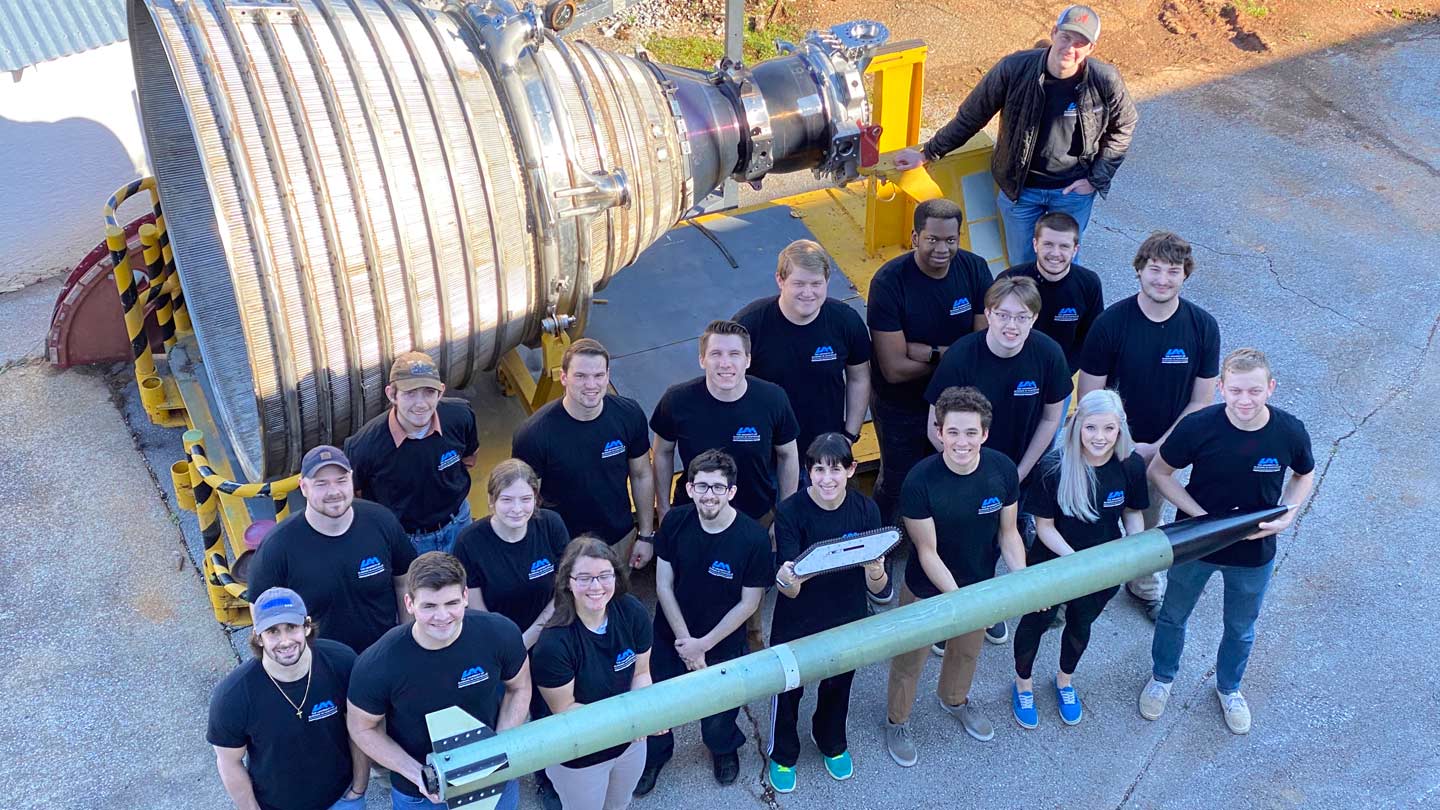
The student team with Baedor, its entry for the NASA Student Launch. This photo was taken prior to the arrival of COVID-19.
David Lineberry | UAH PRC
A student rocket team at The University of Alabama in Huntsville (UAH) earned first place in project safety and third place overall in competition at a COVID-shortened national NASA Student Launch.
“The students worked really hard and faced a lot of technical challenges this year, not to mention a shutdown at the end of the spring semester,” says Dr. David Lineberry, team advisor and a research engineer at the UAH Propulsion Research Center (PRC).
“This is well deserved,” Dr. Lineberry said. “It would not have happened without support from the College of Engineering, the Department of Mechanical and Aerospace Engineering, the Alabama Space Grant Consortium and the PRC.”
The UAH team was mentored by Jason Winningham, who assisted in rocket launches and advised throughout the project.
"We are very proud of the accomplishments of the students and their UAH instructors and mentors,” says PRC Director Dr. Robert Frederick. “Safety is an essential part of rocket science and these experiences will serve them well as they transition to industry."
Named Baedor and designed by the UAH Mechanical and Aerospace Engineering 490/491 Rocket Design team, the rocket carried a rover as its payload. It uses a Level 2 Aerotech L2200G solid fuel motor, is 136 inches long and 6.17 inches in diameter and weighs 61.5 pounds with a loaded motor and payload.
Little Dipper, the rocket’s rover, is piloted by remote control. Its mission was to deploy from the vehicle after landing, advance to a mission collection area and use its scoops to collect samples of simulated ice.
“During the spring semester, as segments of the country started to close down, the team recognized the potential impacts on the project and felt a sense of urgency to complete a demonstration flight,” Dr. Lineberry says. “After a busy couple of weeks, they were able to demonstrate the full vehicle and payload missions at a launch in Woodville, Ala., with the Huntsville Area Rocketry Association.”
Baedor achieved an apogee of 4,454 feet in its final demonstration flight, days before the UAH campus closed as a precautionary measure for COVID-19. When it landed, the rocket successfully deployed Little Dipper, which achieved its collection mission.
Competition category and overall winners were announced virtually by NASA on July 23.
NASA Student Launch challenges middle school, high school, college and university teams from across the United States to build and fly a high-powered amateur rocket carrying a complex payload to over 4,000 feet above the ground. The rocket then must descend and land safely before its scientific or engineering payload can begin its work. This year’s competition drew teams from 19 states and Puerto Rico.
College and university teams developed payloads to navigate to a designated sample site, retrieve a simulated sample of planetary ice, and navigate at least 10 feet away from the site with the sample stored safely aboard. How they tackled the challenge was up to them.
Teams earn points for progress and successes during the eight-month competition, and the team with the most points wins. Awards also are presented in 11 different categories that range from payload design and safety to best social media presence and STEM – science, technology, engineering and mathematics – outreach.
UAH team members are:
- Nicholas Roman, project manager; senior, aerospace engineering, Cullman, Ala.
- Joshua Jordan, chief engineer; senior, mechanical engineering, Mount Vernon, Wash.
- Peter Martin, vehicle team lead; senior, mechanical engineering, Coopersburg, Penn.
- James Venters, payload team lead; senior, mechanical engineering, Huntsville, Ala.
- Jessy McIntosh, safety officer; senior, mechanical engineering, Beaufort, N.C.
- Maggie Hockensmith, technical writing coordinator and vehicle safety deputy; senior, aerospace engineering, Lexington, Ky.
- Claudia Hyder, payload safety deputy; senior, mechanical engineering, Knoxville, Tenn.
- Patrick Day, project management team; senior, aerospace engineering, Johnson City, Tenn.
- Will Snyder, project management team; senior, aerospace engineering, Cleveland, Ohio
- Rodney L Luke, vehicle team; senior, aerospace engineering, Pleasant Grove, Ala.
- Roman Benetti, vehicle team; senor, aerospace engineering, Woodbury, Minn.
- Rachel O’Kraski, vehicle team; senior, aerospace engineering, Huntsville, Ala.
- Ben Lucke, vehicle team; senior, aerospace engineering, Saint Petersburg, Fla.
- Jeremy Hart, vehicle team; senior, aerospace engineering, Gainesville, Ga.
- Jacob Zilke, vehicle team; senior, aerospace engineering, Wilmington, N.C.
- Joseph Agnew, payload team; senior, mechanical engineering, New Market, Ala.
- Johnathon Jacobs, payload team; senior, aerospace engineering, Valley Head, Ala.
- Thomas Salverson, payload team; senor, mechanical engineering, Gretna, Neb.
- Kevin Caruso, payload team; senior, mechanical engineering, Lawrenceburg, Tenn.
- Jacob Moseley, payload team; senior, aerospace engineering, Gaylesville, Ala.